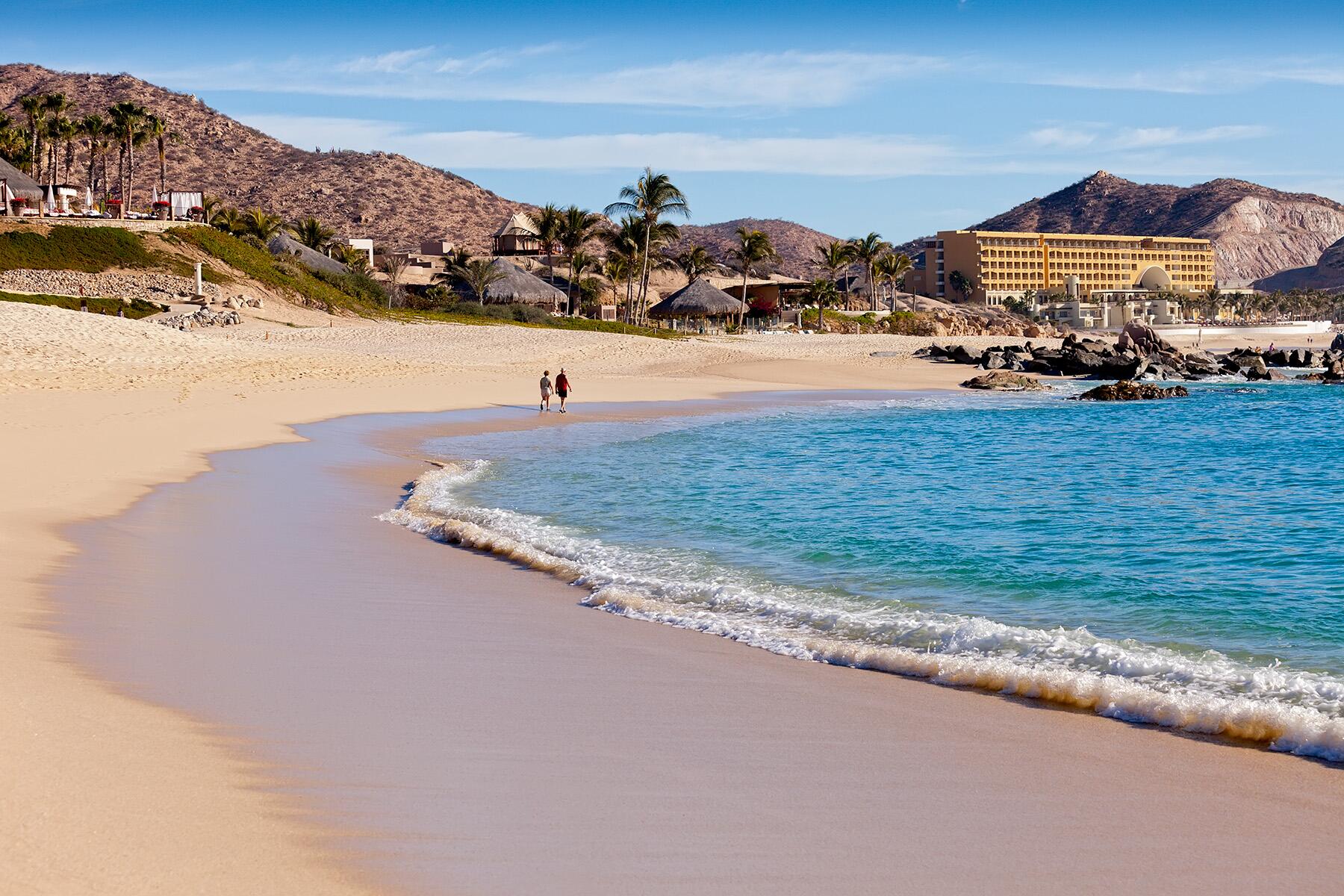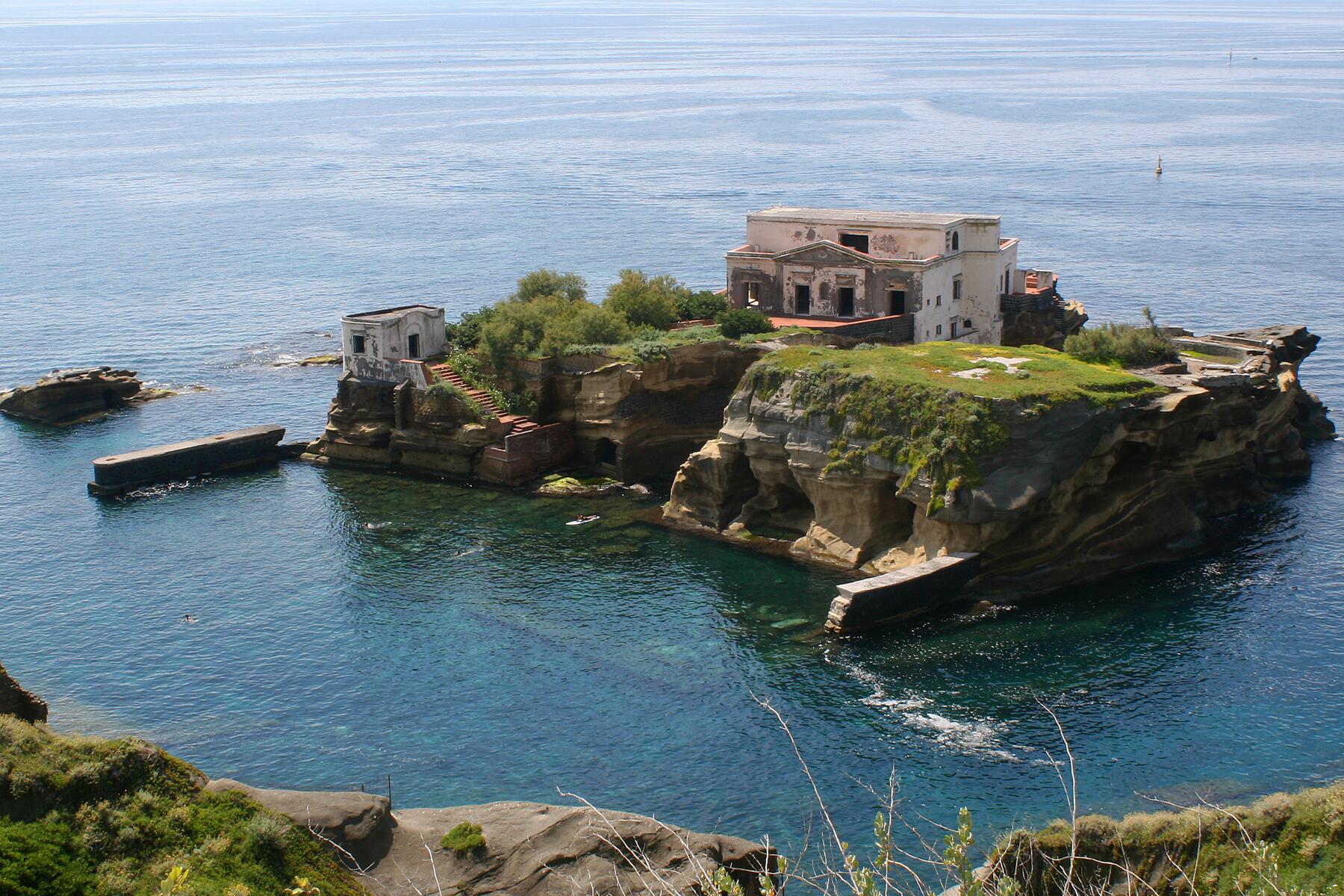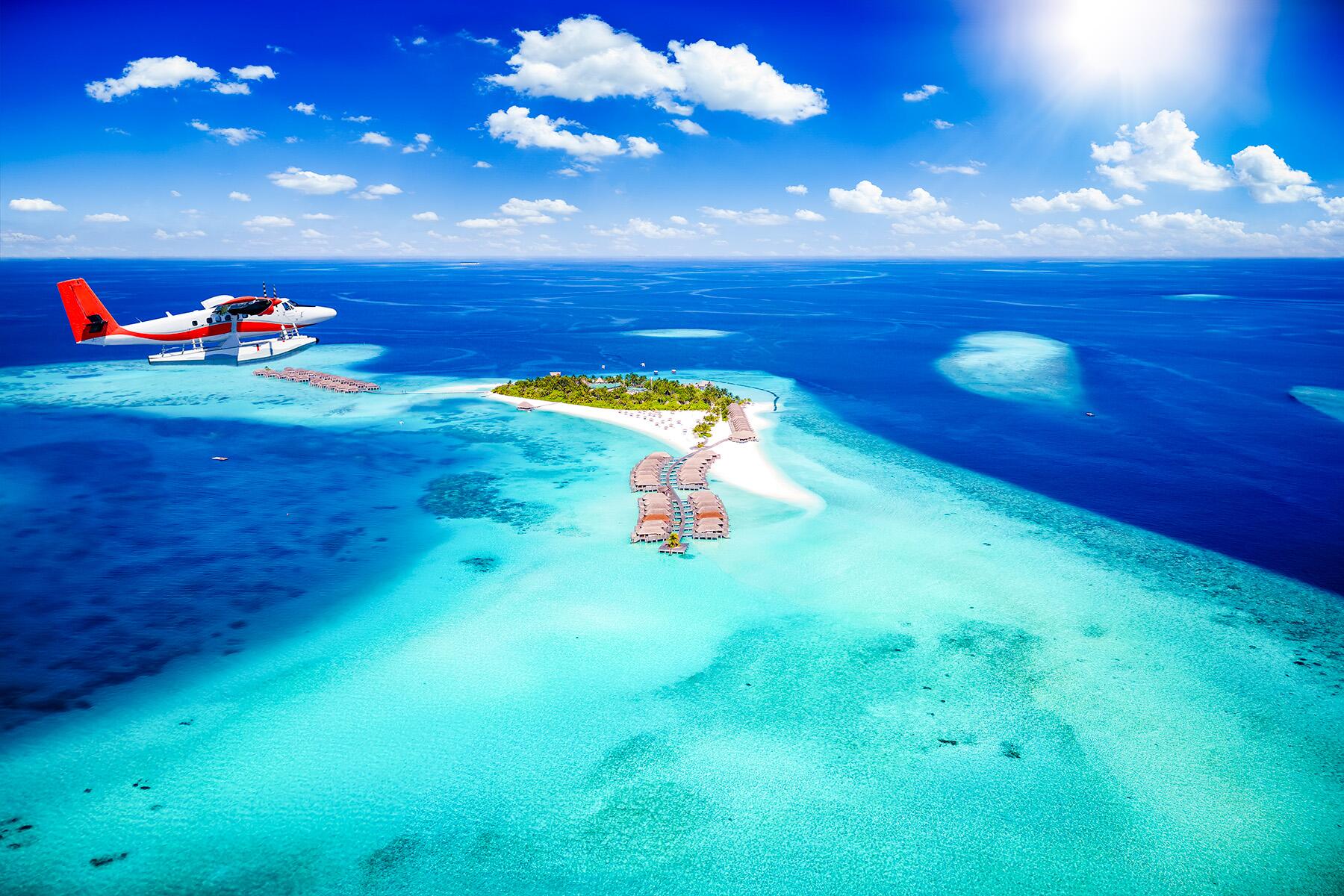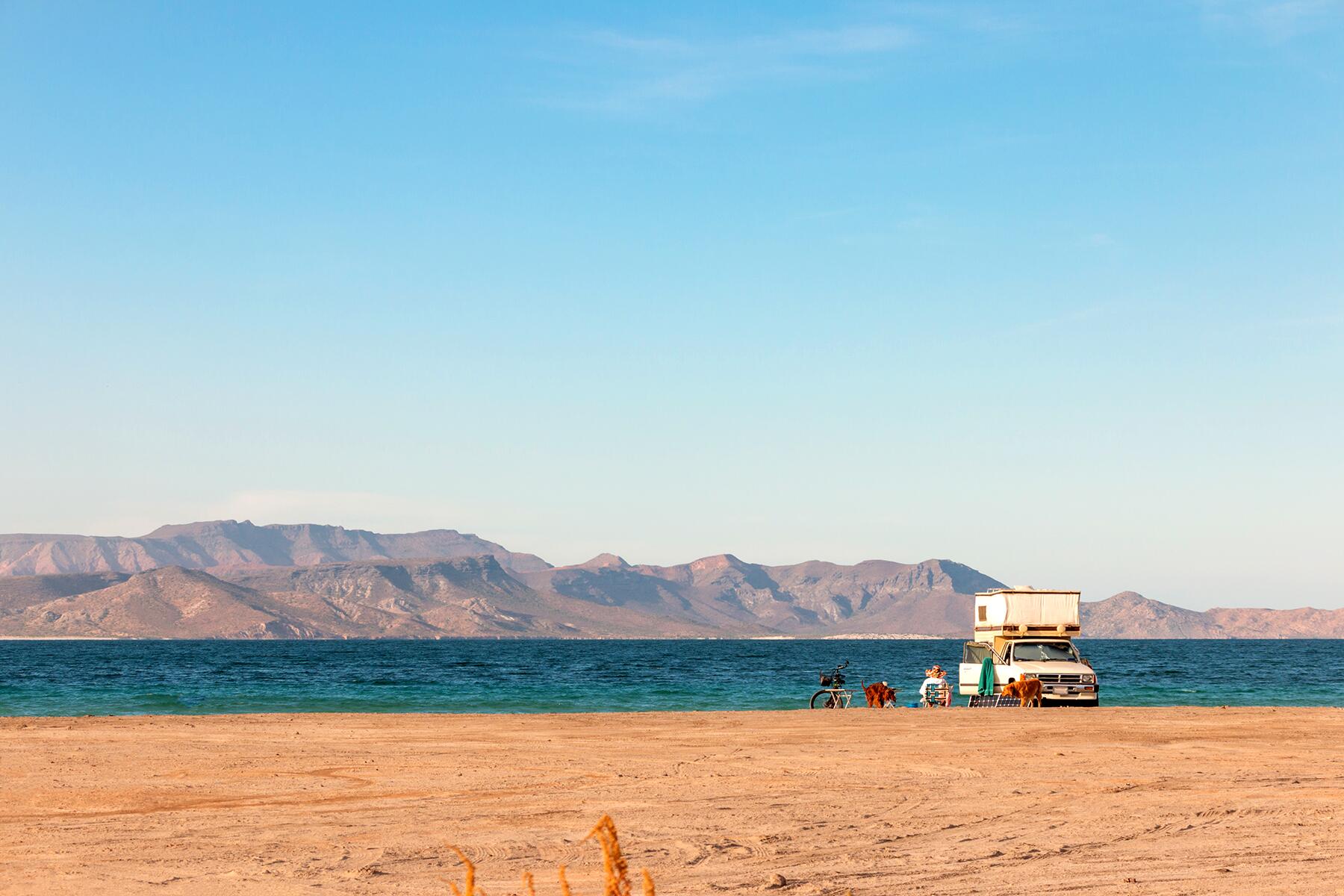Here's everything you need to know before jetting off on this dreamy #vanlife adventure.
Thousands of miles of Cardón cacti, punctuated by palm-fringed oasis and tropical white sand beaches, form the unique ecosystem of the Baja Peninsula. This thin strip of desert jutting out from the West Coast boasts Mexico’s most scenic and accessible road trip. Ribbons of mostly paved highways connect the unpolished border town of Tijuana with Cabo San Lucas, the famed resort destination with turquoise water and sleek limestone arches. Divided into two separate states, Baja California and Baja California Sur, the northern region offers wine country and surf spots while the southern half of the peninsula has wildlife and pristine tropical beaches. Done correctly, Baja can be the road trip of a lifetime where you’ll spend each evening wild camping on an undeveloped beach paradise and indulging in cheap, yet delicious fish tacos or ceviche. But without proper planning, you’ll find yourself stranded on pot-holed roads with a punctured tire, enduring the blistering summer heat, or missing out on all the seasonal local wildlife. Here’s what you need to know for a Baja road trip.
Top Picks for You
Before the Border
Unlike long-term travel through mainland Mexico, the Baja Peninsula doesn’t require you to apply for a tourist visa or a temporary import permit for your vehicle. Instead, you’ll only be required to show proof of valid Mexican auto insurance. This can be easily obtained online for whatever timeframe you need. Border agents may not check when you’re entering Mexico, but be sure you have a valid passport to get back into the U.S. Most importantly, before you cross the Tijuana or Mexicali border, you should download some offline maps or pick up a hard copy because cell service can be spotty through the long stretches of arid desert.
In the far northern region of Baja, between Tijuana and Ensenada, several toll roads require you to pay 40 pesos to pass. These are the newest and smoothest roads allowing you to get your bearings driving in Mexico. Make sure you pull out cash in Tijuana and have some small bills to pay the fee.
INSIDER TIPWhen it comes to Mexican Auto Insurance, nothing is easier than Baja Bound. Curated specifically for road-trippers visiting the peninsula, it’s the cheapest and most customizable coverage.
Rules of the Road
Roadways in Baja are relatively well-maintained but are exclusively single-lane highways with no shoulder, and only a handful are paved at all. The most scenic stretches where you’ll leave the other tourists far behind, often require four-wheel drive to navigate the washboard sand-strewn dirt paths. Know what your vehicle is capable of before you venture off-the-beaten-path.
Although you’ll often be covering 4-6 hour stretches of roadway in a single go, don’t let the desert scenery lull you into complacency. Even on the highest cliffside roads or around the tightest hairpin corners you won’t often find a guardrail or suggested speed sign. Free-roaming cows and burros often meander onto the highway, and the only way to avoid an accident is constant vigilance.
Fortunately for those of us familiar with driving on the right side of the road, there’s no confusion here. But a left blinker doesn’t always mean what you think it does. This is a local signal that lets you know it’s safe to pass on the long stretches of flat highways. So, be extra careful before making a left turn. Speed bumps are also used gratuitously in Baja and are often left unmarked. When you approach a town, it’s customary to slow to 25MPH to avoid rocketing over one of these concealed deceleration devices.
Another potential roadway hazard is flooding. In many regions, dry riverbeds also known as “wash areas” become a roaring stream after heavy rain. This leaves many highways impassable so keep an eye on the weather forecasts.
INSIDER TIPIn major cities across Baja, stop signs are often posted inconspicuously on a tree or hidden behind foliage. It’s best to assume most intersections are a 4-way stop.
Recommended Fodor’s Video
Baja Road Trip Essentials
Before you venture out into the desert, it’s best to come prepared. Both with survival essentials and entertainment. Here’s a checklist to ensure your Baja road trip is both safe and spectacular.
High-Quality Spare Tire & Car Jack: The most common issue travelers face on Baja roads is a popped tire. The highway is scattered with shredded tire remnants, nails, potholes, and rocks hoping to leave your tire in the same condition.
Extra Coolant: Depending on the time of year temperatures can reach 100+ Fahrenheit. If you’re traveling in an older vehicle, the steep mountain inclines can wreak havoc on your engine.
Shovel: Parking on sandy beaches is all fun and games until somebody gets stuck. Pack a shovel to dig yourself out.
Tow Rope or Chain: In case the shovel doesn’t cut it.
Jumper Cables: Although not strictly a Baja road trip essential, it’s important to be prepared for anything when you’re traveling long distances across desolate landscapes.
Four Gallons of Drinking Water: You should always travel with a few gallons of drinking water per person in case of car trouble.
Toilet Paper: Not all public restrooms have the essentials.
Mosquito Repellent: Or window screens so you can enjoy the fresh evening air without buzzing insects.
Pepto-Bismol: Even if you avoid all tap water in Mexico, you may indulge in a meal that will leave you with an unsettled stomach.
Snorkel Gear: Baja has some of the best snorkeling in Mexico. Grab your gear and hit any beach on the Southern or East coast. You’ll likely have an array of tropical fish or sea turtles to yourself.
Inflatable SUP, Surfboard, or Kayak: Whether you stick to the crashing waves of the West Coast or the calm waters of the Sea of Cortez on the East, getting out on the water is the best use of your time in Baja.
Camp Chairs: After a heavy rain sand fleas are omnipresent. If you want to lay on the beach, be sure to sit with a barrier between you and the sand or suffer itchy bites that last weeks.
Shower Bag: Showers can be difficult to locate at times. But you won’t be bothered if you opt to take a wild shower out in the desert.
Pre-Downloaded Podcasts or Other Entertainment: For those long boring stretches of cacti-covered roads.
Books: It’s important to come prepared with technology-free entertainment for all the off-the-grid campsites.
Battery-Powered or Rechargeable Fans: Even if you’re not visiting in the sweltering summertime, it can get warm in Baja, especially when camping away from the cool ocean breeze of the west coast. Fans will help you sleep at night.
INSIDER TIPMany van-dwellers without four-wheel drive will find themselves stuck in the sand a time or two. Instead of packing carpets or burlap sacks to use for traction, you can also use your driver’s seat floor mats. Fortunately, it’s so common to get sand-stuck in Mexico that locals often band together to help get you free.
How to Navigate the Language Barrier
In the major tourist towns of Cabo San Lucas, Tijuana, and Ensenada, you’ll often find locals who speak English with ease. Not so much on the rest of the peninsula. Fortunately, you can brush up on a handful of Spanish phrases to help get you by. As a backup, you should bring a phrasebook or download a translation app to help with more specific requests.
Here’s a handful of phrases that will come in handy while driving across Baja, Mexico. You should also brush up on your Baja Peninsula road signs.
Speed bump: Tope
Dangerous curve: Curva peligrosa
Construction ahead: Tramo en reparación
Stop: Alto
No passing: No Rebase
Extreme caution, dangerous shoulder: Precaución extrema: orilla peligrosa
Bathroom: El Baño (Women’s is often marked with an M for Mujeres)
How much? ¿Cuánto es?
Gas station: Gasolinera
Regular gas: Magna
Fill the tank: Lleno
Open: Abierto
Closed: Cerrado
Help: Ayuda
Drugs: Drogas (This is important because it will often be inquired about at military checkpoints.)
INSIDER TIPAnother unfamiliar trademark of Mexican roadways are military checkpoints. Camouflaged soldiers strapped with automatic rifles search each vehicle, sometimes with dogs, to ensure no contraband is entering the region. There are 7 checkpoints along the road to Cabo, and often they speak no English. Fortunately, they ask the same questions, “Where are you from?”, Where are you going?”, and “Why?”. To which your answers are: “Estados Unidos”, “Los Cabos”, “Turista”.
Plan Your Trip Around Wildlife and Weather
Baja, Mexico is world-renowned for its diverse wildlife encounters. But timing is everything as most marine mammals are migratory and not found near the peninsula year-round. La Paz is one of the few regions in the world where you can ethically swim with wild whale sharks but only during the months of October through May. Mobula Rays can be seen soaring out of the ocean in clouds of flapping wings during two migrations along the Sea of Cortez from April through July and again from November to January. Magdalena Bay boasts the best place to get up-close to notoriously friendly Humpback Whales during the winter months of December through April. Time your visit between January and March and you’ll also chance a glimpse of both Grey and Blue Whales as they head north for the summer.
Many small hidden beaches and protected nature preserves, like Cabo Pulmo, offer year-round snorkeling over stunning coral reefs, colorful tropical fish, dolphins, sea lions, seals, and sea turtles. But if you’re interested in releasing freshly hatched sea turtles into the ocean from one of the many sea turtles preserves along the southern coast, you’ll have to visit from September to December.
By happy coincidence, most of the migratory seasons overlap during the winter months of December to January. This is the best time to plan your road trip through the Baja Peninsula. In the summer months from June to August, temperatures in Baja soar and make car-camping nearly impossible.
INSIDER TIPThose familiar with desert climates will be surprised to find that the Eastern coast of Baja pressed against the Sea of Cortez doesn’t cool down at night. With highs of 100 degrees, the lows will often only dip to a crisp 90 degrees in the summer months.
Water and Amenities in Baja
The Baja Peninsula is the driest and most drought-riddled region in Mexico. But because potable tap water isn’t available, water refill facilities called “Water World” or “Fresk Pura” are easily accessible in almost every town. Because of the water shortage, most van-dwellers stick to infrequent showers with periodic dips in the ocean to wash away the sweat and sand.
If salty sea showers aren’t going to cut it, you’ll find paid showers on many beaches and at hostels in major cities. Gas stations like Pemex almost always have a clean and fully stocked public restroom. Some of their larger facilities even have showers.
When it comes to food, small local grocery stores can be found in any town along the peninsula, while larger cities have international chains like Walmart. In a pinch, the convenience stores called OXXO are everywhere and have everything from road trip snacks, coffee, electrolyte beverages, and lots of Mexican beer.
Gas stations are common and fairly straightforward if you learn the handful of Spanish phrases I listed above. Be sure to tip the attendant 20 pesos if they wash your windows. If you happen to be running short on fuel you’ll notice some roadside entrepreneurs sell gasoline by the bottle. It’s not high quality and there’s no guarantee it won’t mess with your engine but it will do in a pinch.
INSIDER TIPExpect public restrooms to cost about 10-20 pesos or $0.50-$1 for each use.
Breakdowns
Let’s face it, breakdowns happen. Fortunately, Baja has made getting back on the road a breeze. Every town has a plethora of mechanic shops and tire repair stores. Just take a peek at the reviews on Ioverlander if you need a complex repair because some shops are known to overcharge unsuspecting tourists. If you happen to break down or run out of gas in the middle of nowhere (a likely possibility), Baja has a free AAA-like service called the Green Angels who can gas you up or tow you to the nearest town at no charge. They patrol all major highways regularly, but if you happen to have cell service you can give them a call at 664-623-3479.
INSIDER TIPAlthough there isn’t technically a fee for the service of the Green Angel’s, it’s customary to tip. They also only operate from 8 a.m. to 8 p.m., yet another reason it’s best to travel on Baja’s roads during the light of day.
Where to Camp for Free
Everywhere!
Vanlifers in Baja will be pleased to find that, unlike the United States, both beach camping and city stealth camping can be found almost entirely for free. There are very few places you’re not allowed to camp, and those areas will be marked with the trademark signage of an E encased by a red slashed circle. Only the most popular beach destinations charge a small fee of $5 per night (200 pesos, 100 pesos for day use). If you’re looking for more amenities and secure parking, there are also RV campgrounds scattered all across the peninsula.
INSIDER TIPThe most scenic beachfront camping is undoubtedly Playa la Gringa at Bahia de Los Angeles, Playa Balandra, San Pedrito, and Playa Santispac. Beaches can fill up quickly in peak season and on weekends, so be sure to arrive early to ensure a spot on the beach.
How to Plan the Perfect Route
The Baja region is approximately 1,000 miles from tip to toe with two major highways hugging the coastlines and snaking a figure eight across the landscape. The problem most road-trippers face when planning the perfect route is that you’ll have to traverse several long sections of highway twice unless you have the freedom of a four-wheel drive vehicle that can cover the more remote dirt-road regions of the two Mexican states. It’s best in this scenario to carefully plan your drives by hitting half the destinations on the way south, and the other half on the way back up. Breaking up the drive into more manageable chunks ensures you won’t have to stop in all the same cities twice. A potential camping itinerary could be: Ensenada, Bahía de los Angeles, San Ignacio, Mulegé, La Paz, Todos Santos, Cabo, Magdalena Bay, Loreto, Ojo de Liebre, San Felipe, Mexicali.
INSIDER TIPThere is a long stretch of winding road through the desert without a town in sight, beginning at El Rosario de Arriba, where you won’t find a gas station for almost 200 kilometers (124 miles). Be sure to fill up your tank here.
Is a Baja Road Trip Safe?
Mexico is often unfairly represented as a risky travel destination if you stray from the well-trodden resort towns. But in actuality, it’s the small towns that pose the least amount of threat to travelers, solo or otherwise. That’s because your risk of injury increases with the number of cars on the roadway. Just like a road trip across the United States, car accidents are the number one cause of injury and death. Tight corners, exposed pot-holed roadways, and distracted or sleepy drivers should be your only concern when road-tripping Baja.
Theft, assault, or kidnapping are practically unheard of among the vanlife community that travels in Baja. But there’s always safety in numbers. If you don’t feel comfortable camping on an isolated beach with your doors wide open to the world around you, then stick to the most established campsites on Ioverlander. You’ll feel safe, secure, and make lasting friendships with your vanlife neighbors.
Good article. A few notes-
-Hwy 5 crossing through Mexicali is now the easiest and best route with no tolls.
-Don't count on the Green Angels for breakdowns as their budget has been cut and you will rarely see them.
-For drinking water look for "agua purificada" in any town.
-Playa Santispac is great but there are a lot of choices in the area https://heymulege.com/things-to-do/





I just completed a 3000+ mile Slow Baja podcast recording trip in my 50-year-old Land Cruiser FJ40! The roads are your greatest danger. Drive cautiously and pay attention to oncoming traffic. On weekends, many oncoming drivers saluted me by raising a can of Tecate!
The roadside taco stands are usually amazing -look for locals or a window full of stickers. My rule is to fill up everytime you see a gas station. Most stations will take credit cards now, a major improvement when driving an old gas-guzzler like Slow Baja.
Get your F.M.M. Visa, Baja Bound Insurance, the new Benchmark Baja Atlas and download the Slow Baja library and you're good to go!